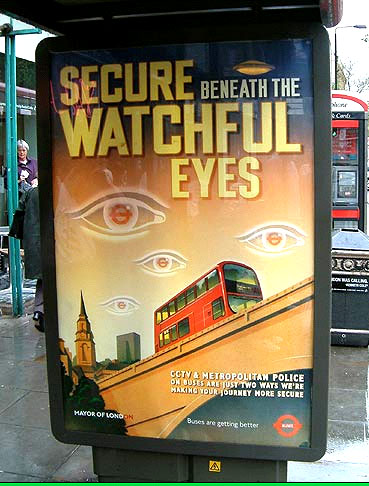

1913: surreptious photography of imprisoned suffragettes begins.
1949: publication of George Orwell's 1984, which is set in London.
1960: Metropolitan Police use two temporary cameras in Trafalgar Square to monitor crowds attracted to the arrival of the Thai royal family.
5 November 1960: Metropolitan Police use two temporary cameras in Trafalgar Square to monitor "Guy Fawkes Day" activity.
1961: installtion of video surveillance system at a London Transport train station.
1964: Liverpool police experiment with four covert CCTV cameras in the city's center.
1965: British Railways installs cameras to watch tracks near Dagenham that had been vandalized.
1967: Photoscan (business) markets video surveillance systems to retail outlets as a means of deterring and catching shoplifters.
October 1968: Metropolitan Police use temporary cameras in Grosvenor Square to monitor anto-Vietnam War demonstrators.
1969: Metropolitan Police install permanent cameras in Grosvenor Square, Whitehall and Parliament Square. Total number of cameras nationally: 67.
1974: installation of video surveillance systems to monitor traffic on the major arterial roads in and through London.
1975: installation of video surveillance system in four London Underground train stations.
1975: use of video surveillance systems at soccer matches begins.
1984: installation of surveillance cameras at major rallying points for public protest in central London. Picketers surveilled during miners' strike.
August 1985: installation of street-based video surveillance system in Bournemouth, a south coast seaside resort.
1987: use of video surveillance systems at parking garages owned by local authorities begins.
1988: installation of video surveillance systems at "council estates" run by local authorities.
1989: civil rights group Liberty publishes Who's watching you? video surveillance in public places.
1992: installation of street-based video surveillance system in Newcastle (a major northern city). The system in Newcastle is closed-circuit television (CCTV) that uses microwaves (an open circuit) to link to the city's main police station.
1992: use of speed cameras and red-light enforcement cameras on the national road network begins.
August 1993: bombing of Bishopsgate in London by the IRA leads to the construction of the "Ring of Steel" around the City (London financial district). Measures include street-based surveillance cameras.
1994: central government (the Home Office) publishes CCTV: Looking Out for You. Prime Minister John Major states: "I have no doubt we will hear some protest about a threat to civil liberties. Well, I have no sympathy whatsoever for so-called liberties of that kind." Between 1994 and 1997, the Home Office spends a total of 38 million pounds of CCTV schemes.
July 1994: use of covert video surveillance systems at automatic teller machines (ATMs) begins.
1996: government spending on CCTV accounts for more than three-quarters of total crime prevention budget.
August 1996: all of England's major cities except Leeds have video surveillance systems in their city centers.
10 May 1997: public demonstration against surveillance cameras in Brighton, organized by South Downs Earth First!.
July 1997: London police announce installation of surveillance camera system that automatically reads, recognizes and tracks automobiles by their license plates.
October 1998: use of face recognition software in the London Borough of Newham begins.
Contact the NY Surveillance Camera Players
By e-mail SCP@notbored.org
By snail mail: SCP c/o NOT BORED! POB 1115, Stuyvesant Station, New York City 10009-9998